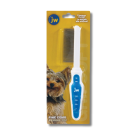
Throughout the United States, ticks are a problem for dogs (and for humans). These blood-sucking pests become more prevalent as temperatures rise and you and your dog spend more time outside. In tall grasses and shrubs, ticks wait for your dog to walk by so they can attach themselves to him or her.
There are a number of deadly diseases carried by ticks, and some of these diseases currently don't have a cure. Therefore, being diligent in checking for and removing ticks is critical whilst always making sure your pet's flea and tick preventative is up to date.
It can be difficult to find ticks on your dog, so here are seven common places to look first:
Head and Ears
Because dogs are curious creatures, they stick their heads into everything, so it's quite common for ticks to find their way onto a dog's head or into his ears as a result. With so many crevices and places to hide, the ears are the ideal place for a hungry tick to set up home. Make sure you check your dog's ears on the outside as well as deep within the ear, because ticks can attach and go unnoticed for a long time. It's a sure sign that something is wrong if your dog shakes his head and scratches at his ears continuously.
Under the Collar
Many dogs rarely have their collars taken off, making this area the perfect spot for ticks to go unnoticed. Usually, ticks in this area will get to the point where they are so large they can be easily seen — unfortunately, this means they have been feeding for a while. Whatever the case, removing your dog's collar to do a thorough check consistently every couple of days, especially in summer, is never a silly idea. It's better to be safe than sorry, just remember to put his/her collar back on for identification purposes.
Eyelids
Ticks near the eyelids often remain unnoticed because they are mistaken for skin tags or eye discharge. By the time owners realize there is a tick on their dog's eyelid, it has already been present for quite some time. The longer a tick remains attached, the greater the risk of transmission of disease.
Armpits
Ticks can also attach high up in the armpit area, where the dog's front legs meet his body. The area is dark and difficult for the dog to reach or for you to see.
Groin
Many dog owners aren't enthusiastic about checking the genital regions of their dogs and we can't blame them. However, this uncomfortable area is a lovely dark and warm region on your pet's body that ticks love to set up shop. Ticks in this area stay hidden by the dog's coat and tail and often remain attached for long periods of time increasing the risk of disease transmission. Whilst this is an uncomfortable area, it's imperative to check - especially in the warmer months.
Tail
In most cases, ticks remain unnoticed on dog's tails due to owners not checking the underside, especially near the base. You'll want to comb through any thick, dense fur on your dog's tail, however, remember to be gentle as most dogs don't like their tail being touched or combed. A fine comb will likely catch a tick that’s attached itself.
Toes
If you notice your dog chewing, licking, or sniffing his feet, there might be something bothering him, and that something could be a tick. Ticks often crawl between the toes or even on the bottom of the foot near the pads.

